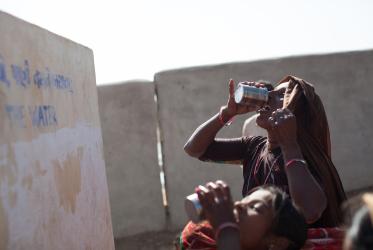Text: “And Jesus said to her, “I am the Living Water”..…everyone who drinks the water will never be thirsty again.” John 4: 4-26 [1]
Reflection:
No community can talk about Tzu(water in Ao-Naga language to which I belong) in a meaningful way without demonstrating its relationship to women. Women carry the primal waters of life and identify more intimately with it. We need to admit that “gendered water” is a fact that has multiple implications: it is a source of life and vitality, a symbol of pain and hard work, and a tool of economic oppression as it has now become an expensive commodity.
In the gospel narrative of John, in chapter 4 we see a conversation where patriarchal-culture-bound-religiosity has radically transformed a community over the issue of water just by a conversation , or perhaps a debate involving a woman. Jesus was asking the Samaritan woman, Photenia,[2]for a drink. After her encounter with Jesus, Photenia directed the entire Samaritan town of Sychar to the “Living Water”—the eternal Way, the Truth, and the Life. From now on, Photenia’s longing for the “Just-Water” in other words, a “gender-balance” resource sharing would be fulfilled . Disillusionment would no longer haunt women folk . No more the energy sapping chore of drawing water that left them parched every day. The dilemma of whether water should be drawn vertically or horizontally, or to beg to the owner is no longer a concern anymore.
In a similar vein, the sacredness of water in my community is traced back to the Diviner, “Ongangla.”[3]Ongangla, the diviner and giver of mother-wisdom of the Ao Naga tribe, advises that every community must pay utmost reverence toward proper managing of creeks and springs. Thus, the history and identity of water is intertwined with the story of women everywhere.
Recently, I checked with some of my sisters and neighbors from my childhood to recall household chores that we fondly remembered. All of us concur with a nostalgic laughter, “waking up before dawn to fetch tzu.” Dry cold season lasts upto six months in our region. In fact, fetching water was the major chore which I did almost every day, from as early as six years old, until I left my hometown Mokokchung for graduate studies.
The politics of water among the indigenous communities in the North East India cannot be understood fully without using a gendered lens. Let me recount, though briefly, my memory of tzu. We were told that water dries up by dawn. Once the rooster sounds its first crow, my sisters and I would wake up quietly and gently walk down the memorized 314 steps to join my neighbors in the queue. We would then pray hard to request water from the owner. If the owner refuses to share water, the option was to trek an hour in search of creeks. On weekends, we would pack tons of dirty laundry of the entire family and wash them in the running forest streams. These were beautiful moments too: running around in the forests, collecting nuts and wild flowers, and enjoying the tea and snacks packed by my mother and elder sisters.
Having said that, the burden on securing water for the families lies disproportionately on the women in almost every culture and society. We are no exception. Every day young children, like during our childhood days, accompany their mothers or sisters and walk miles to fetch water before and after school, thereby arriving late or bunking school in the end. Due to lack of water and sanitation facilities in schools, every month during their menstruation young girls miss school. The missing days simply pile on and finally they discontinue formal education in most cases.
India is known as the world’s largest open air toilet with over 600 million people practicing open defecation. Most men will be seen peeing by the roadside. But what will the women do? Due to lack of proper sanitation facilities, women go out in the open fields, behind bushes, sometimes wait till night falls, or face the nuisance of men who deliberately spy/peep, or take videos, and sexually violate them. Besides compromising with their dignity, women also have to face severe health consequences.
Trying to reduce open defecation numbers from 600 million to zero in 2019 is an ambitious target for India. But if a small percentage of that target can be achieved, it’s a milestone! Besides toilet construction, India needs to deconstruct the psyche of the patriarchal Indian society and can surely provide an opportunity to address this gender divide. On this year’s International Women’s Day's theme is “Think equal, build smart, innovate for change”. This theme can applied to address the issue of “gendered water.”
Reflections:
- What are your memories of water in your childhood?
- How do we see the struggles and injustices related to water as having a direct bearing on the lives of indigenous girls and women?
Action:
- Organize a community-led initiative or a church program to design a implementation plan on how men and boys can actively commit towards and engage in water justice in the community.
- Scientific findings indicate that the water in the North East India is highly contaminated by arsenic and iron where communities pay a huge price on health maintenance. Form a team to find appropriate ways for awareness and advocacy to the right people and communities to address this plague.
References:
John, New Revised International Version, The Harper Collins Study Bible, Division of Christian Education, NCCCUSA, 1989.
Eastern Orthodox tradition identifies the Samaritan woman as Photenia. See Christine Lienemann-Perrin, “Biblical Perspectives on Women’s Impact in Mission,” in Putting Names with Faces: Women’s Impact in Mission History, edited by Christine Lienemann-Perrin, Atola Longkumer and Afrie Songeo Joye (New Delhi: ISPCK, 2014, first publication in 2012 by Abingdon Press), 35.
N. Limatula Longkumer “Rediscovering Women’s Role and Status in Society” in Transforming Theology for Empowering Women: A Theological and Hermeneutical Reflection in the Context of North East India. ed. By R. L. Hnuni, Women’s Studies Eastern Theological College, Jorhat. 1999
https://en.wikipedia.org/wiki/Northeast_India
http://morungexpress.com/origin-of-ao-language/
http://wilsonweb.physics.harvard.edu/arsenic/references/singh.pdf
[1]John, New Revised International Version, The Harper Collins Study Bible, Division of Christian Education, NCCCUSA, 1989.
[2]Eastern Orthodox tradition identifies the Samaritan woman as Photenia. See Christine Lienemann-Perrin, “Biblical Perspectives on Women’s Impact in Mission,” in Putting Names with Faces: Women’s Impact in Mission History, edited by Christine Lienemann-Perrin, Atola Longkumer and Afrie Songeo Joye (New Delhi: ISPCK, 2014, first publication in 2012 by Abingdon Press), 35.
[3]N. Limatula Longkumer “Rediscovering Women’s Role and Status in Society” in Transforming Theology for Empowering Women: A Theological and Hermeneutical Reflection in the Context of North East India. ed. By R. L. Hnuni, Women’s Studies Eastern Theological College, Jorhat. 1999.p. 35.




